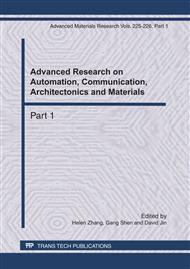p.734
p.739
p.743
p.747
p.753
p.757
p.762
p.766
p.771
Velocity Temperature Characteristics of Time Domain Reflectometry Cable Length Measurement System
Abstract:
Traveling wave velocity is the key to the measuring accuracy of the time-domain reflectometry cable length measurement system. The velocity value is affected by many factors. In order to reduce the ambient temperature impact on velocity, the velocity temperature characteristics of time domain reflectometry cable length measurement system are studied. The change law of the traveling wave propagation velocity in the cable with the change in ambient temperature is studied. The velocity temperature error compensation coefficients of traveling wave in the PVC insulated cable is obtained according to the experimental data by measuring the traveling wave velocity in these cables at different temperature. Experimental results show that the measuring accuracy of the time-domain reflectometry cable length measurement system is improved significantly by velocity temperature compensation.
Info:
Periodical:
Pages:
753-756
Citation:
Online since:
April 2011
Authors:
Price:
Сopyright:
© 2011 Trans Tech Publications Ltd. All Rights Reserved
Share:
Citation:


